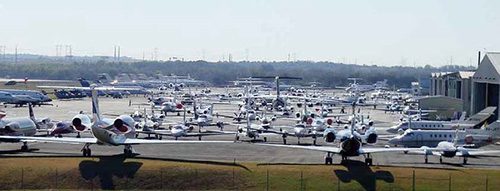 When Formula 1 racing returned to the United States in 2012 after a five-year absence, it drew 265,000 fans to the Circuit of the Americas complex in Austin, TX — a new 1,500-acre facility built just two miles from Austin-Bergstrom International Airport (AUS). Needless to say, the Class-C international airport located in Texas’ capital was central to the global event and its unique travel logistics.
When Formula 1 racing returned to the United States in 2012 after a five-year absence, it drew 265,000 fans to the Circuit of the Americas complex in Austin, TX — a new 1,500-acre facility built just two miles from Austin-Bergstrom International Airport (AUS). Needless to say, the Class-C international airport located in Texas’ capital was central to the global event and its unique travel logistics.
To prepare for the passenger influx associated with the mid-November U.S. Grand Prix, AUS contracted engineering design firm RW Armstrong (now CHA). Its consultants proposed facility modifications and changes to passenger processing procedures engineered to make traffic associated with the premiere race run smoothly. Before a single crewmember or race fan ever set foot in the airport, AUS spent nearly $1 million — $608,000 on construction costs for structural modifications and $380,000 on engineering/architectural services.
|
factsfigures
Project: U.S. Grand Prix Preparation |
Understanding the economics of Formula 1 racing helps put the investments in perspective. The $300 million facility in Austin was designed and built specifically for Formula 1 racing (although it also accommodates other race and concert events). And that’s just pocket change compared to what the overall industry’s outlay. According to AutoWeek magazine, Formula 1 is one of the most expensive sports to compete in, with teams spending $5.4 million to $13.5 million per race. With nearly 20 stops on last year’s schedule, the costs multiply quickly.
In addition, Formula 1 is a serious brain game, and some of the world’s most brilliant scientists are tapped to channel the power of aerodynamics in analyzing speed, fuel load and tire wear to determine the precise moment to boost acceleration through kinetic energy recovery. Research and development for each car is expressed on a multimillion-dollar sliding scale, with tire rotations, speed, weather, and car weight analyzed endlessly — all in an effort to out-think opponents and surge past the crowd to cross the finish line first. It is a battle of wills, wit and a lot of money.
In 2013, there were 19 races in 19 different countries, making travel and logistics an important part of the series. The United States Grand Prix was number 18, just after the Abu Dhabi Grand Prix and just before the series’ final event in Brazil. With one dozen teams participating in the winding 5.5-kilometer race at Circuit of the Americas’ inaugural event in 2012, travel was precisely organized and calculated down to pinpointed arrival times. Similarly, all 12 teams had firm departure times, just three hours after the race end, to facilitate timely arrivals in Brazil for the next race.
Get Ready, Get Set
AUS was the initial gateway to the U.S. Grand Prix — an important cog in the overall Formula 1 machine. As the first point of entry into the United States for most of the race teams and fans alike, its ability to clear high volumes of passengers through Customs in a timely manner was crucial. Because the United States does not have a Formula 1 team, all of the teams would clear Customs at AUS unless they flew into the States earlier at a different point of entry. Each of the 12 teams typically brings as many as 70 people. Add in a cadre of support personnel for the event itself and throngs of fans who come to watch it, and AUS’ usual processing rate of 90 to 110 passengers per hour was not nearly fast enough. Modifying the airport’s U.S. Customs and Border Protection (CBP) area to ensure a positive first impression to travelers was a high-priority objective
“RW Armstrong was useful and had experience in managing special events,” reflects AUS spokesman Jim Halbrook. Mike DeVoy, now senior vice president of CHA, led the firm’s efforts, capitalizing on his inherent understanding of race culture as a resident of Indianapolis.
DeVoy and his team worked closely with AUS’ design, construction, operations and security departments on planning, cost estimates, permitting, bidding assistance, engineering and construction administration. Gresham, Smith and Partners provided the architectural services.
“The goal was to provide a positive impression of Austin and its airport to race fans from across the world,” Halbrook relates.
Modifications to the CBP area nearly doubled the airport’s throughput of international passengers, enabling the airport to clear 160 to 180 passengers per hour. Changes were completed November 9 for the November 18 race, Halbrook reports.
“Enlarging the area allowed CBP to streamline the process,” he explains. “Passengers were able to pick up their luggage and proceed through Customs with their passport and declaration form, streamlining the procedure to one step. That change was able to nearly double the number of travelers processed.”
Modifications were also needed to bring a Boeing 747 aircraft directly to Gate 2 — a first at AUS.
“Convenience for race-goers was a top priority for Austin,” emphasizes DeVoy.
Byron Chavez, DeVoy’s colleague who served as deputy manager for the project, devised a strategy to reconfigure the apron and restripe Gates 2 to 4 to accommodate the 747 along with heavier-than-usual traffic from smaller aircraft. “The change did accommodate the B747-400 aircraft at Gate 2 and passengers were routed through Baggage Claim and Customs effectively,” reports Chavez.
By November 18, AUS had nearly 500 private and commercial jets on its airfield, ready to depart right after the race. At the peak of commercial activity, the airport had four times its usual amount of traffic, recalls Halbrook.
But AUS went beyond accommodating extra aircraft on the tarmac; it strove to deliver the “full Austin experience.” To do so, it recruited 75 volunteers to act as airport and event ambassadors. Each wore a “Welcome Race Fan” button pinned to the front of a bright yellow t-shirt featuring the airport and racetrack logos.
Halbrook describes the ambassadors as “aviation enthusiasts who are thrilled to participate in area events.” Volunteers and employees alike viewed a 10-minute customer service training video that stressed the importance of being fast, friendly and clean. AUS created the curriculum especially for Formula 1 events.
The facility itself was festooned with banners welcoming race fans and special kiosks were positioned strategically throughout the terminal to maximize passenger touch points, notes Halbrook. In total, nearly 4,750 guests visited the airport’s Information Center and help kiosks.
Airport guests were even serenaded as they exited the terminal. “Providing a true taste of Austin, race fans were treated to live music with additional shows added specifically during peak arrival and departure times,” adds Halbrook.
AUS also created a dedicated website with airport-specific information for the event.
In June, the airport’s Grand Prix efforts were recognized with a first place award for customer service initiatives from Airports Council International – North America.
Exit Strategy
Anticipating more than 200,000 out-bound travelers, AUS reorganized its ground transportation network to avoid congestion and confusion. Hotel shuttles and taxis were separated onto different levels, and rental car returns were rerouted. To manage the return flow, intakes were redirected to respective brands’ lots, where on-site staff accepted returns and shuttles stood ready to transport travelers to the airport terminal. In total, the agencies processed more than 5,000 rental contracts throughout the event.
Despite numerous successful modifications and accommodations, all of AUS’ goodwill could have been negated if travelers got stuck at security checkpoints while trying to depart. So the airport tasked RW Armstrong to work with its staff and TSA to prevent such problems. Together, they opened an unused corridor of the airport and created a fourth security checkpoint for use during peak travel times.
The additional four-lane checkpoint opened on November 13 and increased the airport’s passenger screening capabilities by 36%. According to Halbrook, waits during most of the Grand Prix event were less than 20 minutes. At 6:30 a.m. the day after the race, line times extended up to 35 minutes, but dropped back to 20 minutes just before 7 a.m., he notes. Prior to opening the fourth checkpoint, wait times had stretched well over an hour during other large events, such as Austin’s South by Southwest music festival.
TSA officers set a new daily screening record at AUS by processing 21,725 passengers after the first U.S. Grand Prix, then promptly broke it after the 2013 race by more than 1,000 passengers. Most days, they screen 10,000 to 14,000 passengers.
With this year’s race spanning Halloween weekend, TSA and airport officials are undoubtedly already making plans to accommodate more record-breaking crowds.


